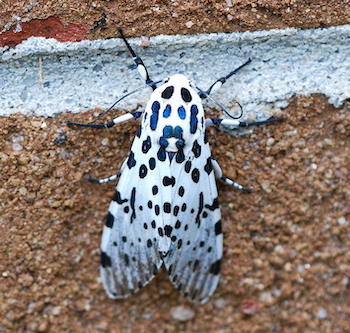
By Terry W. Johnson
One of our most distinctive nighttime flying jewels is the giant leopard moth. This insect’s beauty rivals that of any of the well-known butterflies that flutter across our backyards from spring into fall.
However, since it is a creature of the night, we rarely see it.
With a name like giant leopard moth, you might think this large moth should display the ferocious nature of the leopard, which roams the wilds of Asia and Africa. Nothing could be further from the truth. Taxonomists dubbed it the giant leopard moth because its wings are covered with leopard-like spots. These spots vary from black to blue. Some even have white centers.
While I have no problem with this handsome moth being named for a leopard, it might have been more appropriate to call it the Dalmatian moth.
The female leopard moth is smaller than its male counterpart. Males have a wingspan of about 3.6 inches, while the wingspan of females is only 2.25 inches.
Although the giant leopard moth can conceivably be seen in just about any backyard throughout Georgia, if you knew nothing about the elusive moth and had the task of venturing into the night to capture one, you would probably return home empty-handed. What you need most for a successful search is that the giant leopard moth is attracted to lights. The best strategy, then, would be for you to pull up a lawn chair near an outside light and wait for the moth to come to you.
If there is a giant leopard moth in the area, there is a chance it will come to your light.
When one does show up, chances are it will be a male. For some reason, females do not visit light nearly as often as the males.
While some homeowners report seeing more than a dozen giant leopard moths gathering around a single light, I must confess I have never seen more than one at a time.
Sometimes giant leopard moths can be found in the daytime on the ground or on walls near an outside light. If you try to touch them, they might try to appear dead. This ruse is often accompanied with the moth curling up to expose it abdomen. If this doesn't deter what the insect interprets as a predator, it will emit a yellow fluid.
The moth also has a few other ways to protect itself from being eaten. Obviously, it is always best not to be spotted by a predator. Biologists believe the odd white and black pattern displayed on the insect's wings are a form of disruptive coloration. As odd as it may seem to us, this pattern supposedly makes the giant leopard moth harder for bird or other predators to spot.
The moth's nocturnal habits also greatly reduce the chance it will be spotted by a bird simply because most of them are active during the daytime. Unfortunately for giant tiger moths, whip-poor-wills, chuck-wills-widows and bats are on the prowl when the sun goes down and will not turn down the opportunity to dine on a big, juicy moth.
To avoid bats, the giant leopard moth has more options. Remarkably, the moths have ears that are behind the spot where its hind wings join the body. Lepidopterists, those who study or collect moths and butterflies, believe these organs enable giant leopard moths to detect the echolocation sonar the bats use to detect their prey. The moth even has the ability to produce clicking sounds. The theory is these sounds are used to jam the bat's echolocation system.
If you haven’t seen one of these striking insects, there is no better time to search for one than now. If you don't find one right away, don't give up: Giant leopard moths can be seen in the Peach State throughout the summer.
Terry W. Johnson is a former Nongame program manager with the Wildlife Resources Division and executive director of The Environmental Resources Network, or TERN, friends group of the division’s Nongame Conservation Section. (Permission is required to reprint this column.) Learn more about TERN, see previous “Out My Backdoor” columns, read Terry’s Backyard Wildlife Connection blog and check out his latest book, “A Journey of Discovery: Monroe County Outdoors.”



















